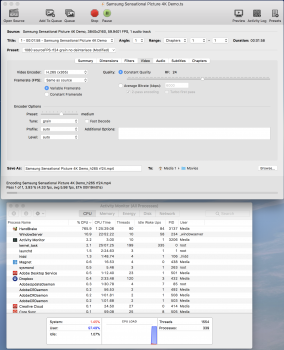In the Handbrake docs it states that there will be an "H.264 (Intel QuickSync)" encode option if QuickSync is available. I did select your preset and was careful to make sure the settings were as you specified.Yes, I can only encode those options...MKV container will add a few more for you, but h.265 is the best bang for your buck.
Edit: also, it looks like you didn't select the profile after you selected the video. Could you double check that?
Have you run the H.264 encode on your machine?
[doublepost=1515518788][/doublepost]
That was using H.265. I also did a run using H.264, and that ran much faster, 18.75 fps. I checked very carefully to see that my settings matched what Trebuin specified. This is very strange. Have you tried running H.264?You can always encode with H264. One of the main benefits with H265 is file size for the quality. It's close to half the file size of a comparable quality H264 which adds up if you have a lot of videos.
[doublepost=1515510221][/doublepost]
Was that using H264 or h265? My 2017 iMac wasn't able to process that test as fast so I'm curious if you did something wrong with the settings he suggested.
2017 iMac i7, 40gb ram, Radeon 575 4gb card: encoded 7110 frames in 2371.22s (3.00 fps), 36972.98 kb/s, Avg QP:21.15 (using public version)
2017 iMac i7, 40gb ram, Radeon 580 8gb card: encoded 7110 frames in 2276.09s (3.12 fps) (using the nightly build)
Thinking about this some more, logically there is no way that the iMac Pro should be running this encode more than 7 times faster than your 2017 i7s. And it goes without saying that they should be faster than my 2014. At the same time, it seems reasonable to me that the iMac Pro is 3 times faster than mine. So, I think there must be something off in your settings.
Just to be sure, I reran the H.265 encode one more time and got the same result.
Last edited:







